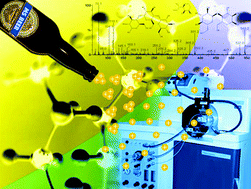Electrospray ionization mass spectrometry fingerprinting of beer
Abstract
After just simple degassing, dilution, pH adjustment and direct flow injection, characteristic fingerprint spectra of beer samples have been obtained by fast (few seconds) electrospray ionization mass spectrometry (ESI-MS) analysis in both the negative and positive ion modes. A total of 29 samples belonging to the two main beer types (lagers and ales) and several beer subtypes from USA, Europe and Brazil could be clearly divided into three groups both by simple visual inspection of their ESI(+)-MS and ESI(−)-MS fingerprints as well as by chemometric treatment of the MS data. Diagnostic ions with contrasting relative abundances in both the positive and negative ion modes allow classification of beers into three major types: P = pale (light) colored (pilsener, pale ale), D = dark colored (bock, stout, porter, mild ale) and M = malt beer. For M beers, samples of a dark and artificially sweetened caramel beer produced in Brazil and known as Malzbiers were used. ESI-MS/MS on these diagnostic beer cations and anions, most of which are characterized as arising from ionization of simple sugars, oligosaccharides, and iso-alpha-acids, yield characteristic tandem mass spectra adding a second and optional MS dimension for improved selectivity for beer characterization by fingerprinting. Direct ESI-MS or ESI-MS/MS analysis can therefore provide fast and reliable fingerprinting characterization of beers, distinguishing between types with different chemical compositions. Other unusual polar components, impurities or additives, as well as fermentation defects or degradation products, could eventually be detected, making the technique promising for beer quality control.


 Please wait while we load your content...
Please wait while we load your content...